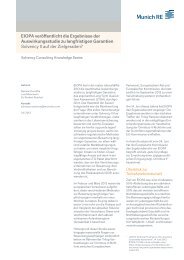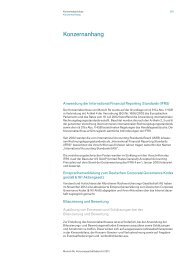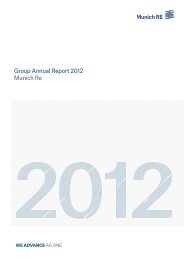Munich Re Group Annual Report 2006 (PDF, 1.8
Munich Re Group Annual Report 2006 (PDF, 1.8
Munich Re Group Annual Report 2006 (PDF, 1.8
You also want an ePaper? Increase the reach of your titles
YUMPU automatically turns print PDFs into web optimized ePapers that Google loves.
<strong>Munich</strong> <strong>Re</strong> <strong>Group</strong> <strong>Annual</strong> <strong>Re</strong>port <strong>2006</strong> Notes_Disclosures on the uncertainties of future cash flows from insurance contracts<br />
Premiums, loss ratios and combined ratios by class of business<br />
<strong>2006</strong> 2005 2004 2003 2002<br />
Gross premiums written in €m<br />
– <strong>Re</strong>insurance<br />
– Liability 2,394 2,561 2,606 3,444 3,514<br />
– Accident 713 1,052 1,080 1,293 1,302<br />
– Motor 2,913 2,671 2,890 3,186 3,337<br />
– Marine, aviation, space 1,751 1,654 1,609 1,742 1,896<br />
– Fire 3,763 3,701 3,775 4,874 5,294<br />
– Engineering 1,239 1,299 1,281 1,393 1,443<br />
– Other classes of business 1,778 1,609 1,616 1,987 2,098<br />
– Primary insurance<br />
Loss ratio in %<br />
– <strong>Re</strong>insurance<br />
5,147 5,242 5,202 5,082 4,841<br />
– Liability 81.7 96.6 96.4 84.1 144.4<br />
– Accident 134.0 83.4 82.2 72.8 128.6<br />
– Motor 84.9 71.5 87.6 79.1 84.6<br />
– Marine, aviation, space 67.7 80.8 66.1 60.0 72.7<br />
– Fire 32.2 107.8 54.2 60.3 80.9<br />
– Engineering 56.4 40.0 57.4 64.4 75.8<br />
– Other classes of business 50.9 63.4 47.1 60.3 98.2<br />
– Primary insurance<br />
Combined ratio in %<br />
– <strong>Re</strong>insurance<br />
55.8 58.4 58.1 60.0 62.4<br />
– Liability 110.7 124.8 124.2 112.0 171.2<br />
– Accident 167.7 111.0 115.8 103.8 158.2<br />
– Motor 109.7 94.6 112.7 102.7 107.8<br />
– Marine, aviation, space 91.5 106.6 89.6 84.8 95.0<br />
– Fire 58.8 135.8 8<strong>1.8</strong> 86.5 107.3<br />
– Engineering 87.8 75.3 89.5 94.5 105.2<br />
– Other classes of business 83.4 98.1 75.5 89.6 130.6<br />
– Primary insurance 90.8 93.1 93.0 96.4 99.9<br />
The estimation of technological, social and demographic parameters<br />
plays an important part in assessing and pricing risks assumed in all<br />
classes of business. Beyond this, in liability insurance and sections<br />
of motor insurance, the development of economic and legal parameters<br />
is significant, whereas in the lines of business fire and marine,<br />
aviation, space and sections of engineering business and primary<br />
insurance, a high degree of sensitivity regarding the underlying<br />
assumptions about natural catastrophes can play the dominating<br />
role. In the latter area, we include expected trends in our considerations<br />
when assessing the risks, with special importance given to a<br />
precise analysis of climate-related changes in the risk profile.<br />
<strong>Re</strong>serve risks<br />
Provisions for outstanding claims are subject to the risk that actual<br />
claims settlement may be less than or exceed the amount reserved<br />
(reserve risk). Particular attention is given to those situations where<br />
the funds dedicated to future claim payments may be inadequate.<br />
204<br />
The measurement of the provisions for outstanding claims is based<br />
on historical loss development data for the different classes of business.<br />
We use a range of well-established actuarial methods in both<br />
reinsurance and primary insurance for this purpose. These methods<br />
embed various pricing, coverage and benefit/inflation levels. The<br />
actuarial analysis is complemented by studies carried out by our<br />
claims and underwriting staff from which we derive foreseeable<br />
future trends. As part of our regular results monitoring process, we<br />
keep a close eye on trends to ensure that the assumptions underlying<br />
the measurement of the provisions always reflect the latest<br />
developments. Consequently, in the course of reserve run-off, it may<br />
be necessary to revise the original estimates of the claims expenditure<br />
required and to adjust the provisions accordingly. We view our<br />
level of reserves as sufficient to reflect both our best estimate of our<br />
current liabilities and an appropriate consideration of the uncertainty<br />
inherent in the estimate. It should, however, be noted that future<br />
changes to the provisions cannot be ruled out.

















